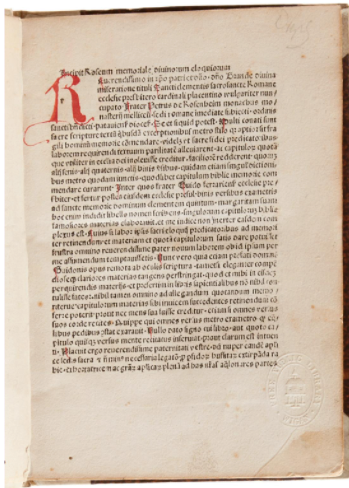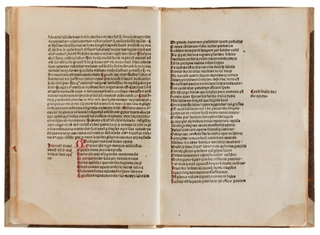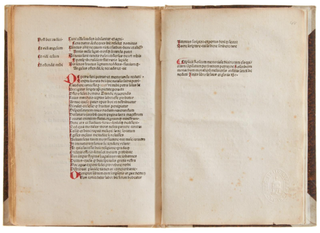incipt Roseum memoriale divinorum eloquiorum
[Köln] : [Southern Germany : n.pr., about 1480-90?] or [Cologne? : n.pr., about 1483] or [Ludwig von Renchen?], 1483 Deutschla, ca. 1480. Rubricated and initials supplied in red and blue. First Edition. First edition. - First blank almost loose, with backed tear and torn of corner as well as "Rosarium sup(er) bibliam" in old handwriting, flyleaf with purchase note dated 1908, small water stain on the bottom corner in the first half of the work, slightly soiled and tanned. - Wide margined copy from the Wican Free Public Library (blind stamp and bookplate). - 19th centuy half vellum (slightly scrachted and scuffed). ¶ This is one of the earliest printed books on the ars memorativa or mnemotechnics the rare first edition of the Roseum memoriale composed by the German Benedictine monk Petrus of Rosenhaym (Upper Bavaria), written between 1423 and 1426 for Cardinal Giulio Branda di Castiglione. Petrus of Rosenhaym composed numerous treatises, sermons, and verses: the Roseum memoriale is surely his most famous work, enjoying wide popularity during the fifteenth century and first half of the sixteenth century.
¶Each couplet commences with a different letter in the order of the alphabet (omitting K, X, Y, Z, but including vowel I). These letters correspond to the numbers that appear on the cuts, and together form a method of memorizing the events of the Scripture as told by each of the Evangelists. It is a poem composed of 1,194 verses followed by an epilogue of seventy-three hexameters, in which every chapter of the Bible (excluding the Psalms) is summed up in a distich. The mnemotechnic method here employed is extremely complex: the hexameters of each section of the summary form an acrostic of the letters of the alphabet.
¶ Based on Latin verses about Holy Scripture, it uses characteristic couplets (distiches) to express the main content of all chapters of the Old and New Testament.
¶ A highly popular and broadly used manual, its copies could be found in almost every European church after the invention of the printing press it was printed in several different locations. This early medieval incunable has not been clearly dated (This edition) researchers attribute it to the Upper Rhine region sometime between 1480 and 1483. . After 1423, he was appointed 'cursor biblicus' and 'magister studentium'.
Dated in Goff and IGI about 1483 "The edition is assigned by Proctor to the printer Ludwig von Renchen, active in Cologne from 1483 to ca. 1495, while ISTC gives Southern Germany between 1480-1490 and GW tentatively suggests Oberrhein, 1483. Item #803
Quarto (190 x 155 mm). ( a-f8 ) [1-68]. [48] a1 blank and lacking. Text in one column, 32 lines. Type: 80G. Initials painted in red, rubricated in red ink throughout . First edition . ¶Gothic script, rubricated, red and blue hand-painted initials, 92 unnumbered pages. A very good copy, old repair to the first blank leaf, a few spots, pale stain at the lower blank corner of the first quires.
¶ISTC ir00336000; Goff R336; BMC I 312; ; GW M32724; Polain(B) 3128; IBE 4559; IGI 7668; IBP 4380; Sajó-Soltész 2676; Madsen 3549; Borm 2134; Hubay(Würzburg) 1704; AmBCat 199; Walsh 492; Oates 867; Pr 1517; BSB P-362; Van der Haegen II,2:16,4?; Young 278.
Price: $15,500.00




